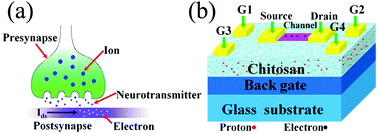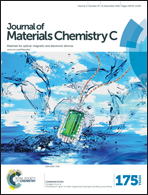Artificial synapses based on biopolymer electrolyte-coupled SnO2 nanowire transistors†
Abstract
The fabrication of biologically inspired solid-state devices has attracted tremendous attention for decades, and the hardware implementation of artificial synapses using individual ionic/electronic hybrid devices is very important for neuromorphic applications. Herein, electric double-layer (EDL) synaptic transistors coupled by proton neurotransmitters with a multiple in-plane gate structure were successfully fabricated using SnO2 nanowires. Not only the important synaptic functions were mimicked in these devices, but also the synaptic behaviors can be modulated over a dynamic range via the multi-terminal regulation of synaptic inputs. Furthermore, a light source was used to illuminate the SnO2 nanowire synaptic transistors, which were used as the light-modulating terminals. The observed neuromorphic functions were also dynamically modulated via the light density. These excellent nanoscale synaptic transistors may find significant applications in synaptic electronics.


 Please wait while we load your content...
Please wait while we load your content...